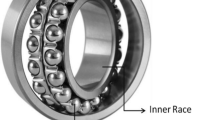Abstract
This article discusses practical differences between high-cycle fatigue and low-cycle fatigue at relatively lower temperatures in rotating equipment and the equipment attached to it. Methods to identify the failure mode are discussed so proper prevention measures can be put in place to prevent future occurrences. Examples of typical components are provided to show the methods in action.



















Similar content being viewed by others
References
T. Sakai, Review and prospects for current studies on very high cycle fatigue of metallic materials for machine structure use. Fourth international conference on very high cycle fatigue, 2007.
G. Chai, Subsurface non-defect fatigue crack origin and local plasticity exhaustion. 13th international conference on fracture, June 16–21, Beijing, China.
V. Kazymyrpvych, Very high cycle fatigue of engineering materials (literature review), Karlstad University Studies, 2009:22.
R. Stone, Fatigue life estimates using goodman diagrams. SMI encyclopedia of spring design.
N. Dowling, Mean stress effects in stress-life and strain-life fatigue, SAE Technical Paper 2004-01-2227.
P. Lukas, Low cycle fatigue and elasto-plastic behavior of materials, Elsevier, 1998.
N. E. Cherolis, Fatigue in the aerospace industry – is it HCF or LCF? MS&T 2012, unpublished presentation.
S.D. Antolovich, A. Saxena, “Fatigue Failures,” Metals Handbook, Ninth Edition, Volume 11, p. 111.
N.E. Cherolis, Fatigue in the aerospace industry: Striations. J. Fail. Anal. Prev 8(3), 255–258 (2008)
NTSB Materials Laboratory Report No. 90-2, NTSB/AAR-90/06.
L. Gonzalez, Flight 232: A Story of Disaster and Survival (W. W. Norton & Company, New York, 2014)
Guidelines to Minimize Manufacturing Induced Anomalies in Critical Rotating Parts, DOT/FAA/AR-06/3, 2006.
S.S. Manson, A.J. Meyer Jr., H.F. Calvert, M.P. Hanson, Factors affecting vibration of axial-flow compressor blades. Proceedings of the society for experimental stress analysis, vol. 7, No. 2, 1948.
Vibration Fatigue Testing of Socket Welds, EPRI Report TR-107455.
D.N. Hopkins, D.J. Benac, Investigation of fatigue-induced, socket-welded joint failures for small-bore piping used in power plants. Pract. Fail. Anal. 1(2), 71–82 (2001)
D.J. Benac, Technical brief: avoiding bolt failures. J Fail. Anal. Prev. 7(2), 79–80 (2007)
Author information
Authors and Affiliations
Corresponding author
Rights and permissions
About this article
Cite this article
Cherolis, N.E., Benac, D.J. & Pridemore, W.D. Fatigue in Rotating Equipment: Is it HCF or LCF?. J Fail. Anal. and Preven. 16, 828–841 (2016). https://doi.org/10.1007/s11668-016-0162-6
Received:
Published:
Issue Date:
DOI: https://doi.org/10.1007/s11668-016-0162-6




